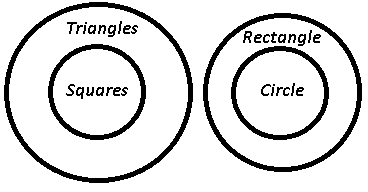In each question below are two/three statements followed by two conclusions numbered I and II. You have to take the two/three given statements to be true even if they seem to be at variance from commonly known facts and then decide which of the given conclusions logically follows from the given statements disregarding commonly known facts.
Give answer a: if only conclusion I follows.
Give answer b: if only conclusion II follows.
Give answer c: if either conclusion I or conclusion II follows.
Give answer d: if neither conclusion I nor conclusion II follows.
Give answer e: if both conclusion I and conclusion II follow.
Statements :
All squares are triangles.
No triangle is circle.
All circles are rectangles.
Conclusions :
I. No rectangle is square.
II. All rectangles being square is a possibility.
Solution
The venn diagram for above statements is :

Conclusions :
I. No rectangle is square = may or may not be true
II. All rectangles being square is a possibility = false
Thus, neither conclusion I nor conclusion II follows.
=> Ans - (D)
Create a FREE account and get:
- Banking Quant Shortcuts PDF
- Free Banking Study Material - (15000 Questions)
- 135+ Banking previous papers with solutions PDF
- 100+ Online Tests for Free

